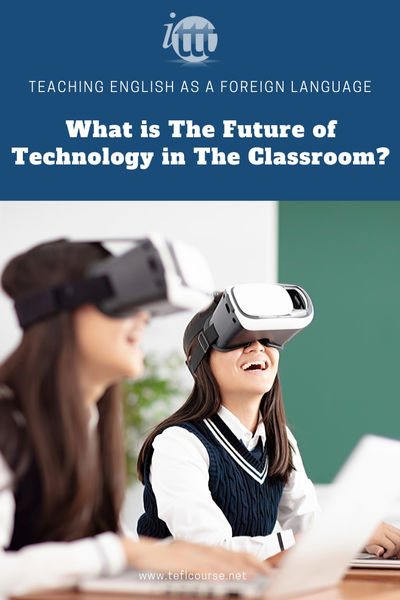What is The Future of Technology in The Classroom?

Twenty years ago as an elementary school principal in a large inner-city school district, the staff and I took great pride in creating what we considered to be an exemplary high-technology school. We believed that technology could serve as an excellent tool for children to develop critical thinking and deductive reasoning skills, deeper conceptual understanding, and the ability to communicate their understanding to others. This new paradigm was called inquiry-based information shifting teaching from a teacher-directed approach to a student-centered approach where the students acquired the skills necessary to access and use information. Of the many new initiatives, we started at this elementary school was a "Writing to Read" lab in K-1, a full-time computer teacher, a partnership with a software company developing new educational software directly inside our K-1 classrooms which gained us state-wide recognition and a lot of foundational support.
Table of Contents
Do you want to teach English abroad? Take a TEFL course!
This post was written by our TEFL certification graduate Rex P. Please note that this blog post might not necessarily represent the beliefs or opinions of ITTT.
Computerization of Classrooms
We installed 15 computers in every classroom with a planned curriculum for every grade level, et al., with a PowerPoint/HyperStudio program that began in second grade. By the time fifth grade came along our students could create the necessary PowerPoint and HyperStudio cards that included integrating with those presentations not only text, but visuals, art, voice recordings, graphics, animation, and personalized videos, etc. as well. What we found out was that no matter how much the technology changed from year to year, the presentation and public speaking skills of those fifth graders improved greatly.
Twenty years ago, after computer-assisted instruction and computer-managed instruction de-emphasized the role of the teacher, we moved into computer-enhanced instruction. This instruction provided less structure and more open-ended opportunities that supported a particular lesson or unit but the teacher is central to the instruction by structuring the experience and consistently interacting with students. Today, I see technology innovation in some schools that consist of satellite downlinks, the heavy use of Youtube, Twitter, Facebook, multimedia, wi-fi, Intranet/Internet, electronic games, and multitudes of peripheral and portable devices, et al. In more and more specialized schools there are STEM-focused platforms with virtual and augmented reality, and advanced, low-latency robotics, all with immense collaboration experiences. Two of my principal friends say that being able to interact with transformative technologies like these will further prepare our students for tomorrow's digital world.

Also Read: Do I need a degree to teach English abroad?
Projects
I was visiting a STEM middle school and principal friend that I had known for over 25 years a few weeks ago and he took me to visit a classroom. Some of this teacher's students were immersed in a robotics project, others in self-described virtual and augmented reality projects, four involved in SCRATCH, a programming language for kids, and a 3-D printing project. The teacher said "My goal is building capacity in students. I can't teach them to be creative, but I can teach them how to use tools to help themselves express their creativity." I watched one student lean over a table to watch a Cue robot travel five miles per hour. The student used his device to control the Cue robot's movements. "This is a good tool for programming," the sixth-grader says. "When you tell a robot to do something, it does it. They don't have common sense." The student shared that if he didn't plot the robot's path and code accordingly, the mechanism would simply roll off the table and crash on the floor.
Another interesting project in a STEM classroom that creates passion for students is the 3-D printer. When I was there the student took a fellow student's shoes, scanned one of the shoes with a device creating a 3-D file. As I understood the project the 3-D file will be scaled down as it was related to a scaling (math) project that they had been studying. My friend showed me that the teacher had 8 projects listed on the whiteboard at the front of the class and he allows his students to choose different projects each week and students are allowed to work in groups. He told me that technology has provided more interactive opportunities, transforming how students create and explore projects. My principal friend told me that today his school uses many virtual classroom software including two math apps which include Khan Academy, which automatically inputs students' MAP scores, a standardized test took three times per year.
Do you want to teach English abroad? Take a TEFL course!
Finally, I want to also mention a technological advance that my school district as a whole instigated two years ago. Over the last two years, I worked as an Administrator for ITD for central district offices for 900+ schools for Professional Learning and Leadership Development for new administrators – and two key online system components: (i) My Integrated School Information System (MISIS) for the Online Gradebook and the Learning Management System; and (ii) My Professional Learning Network (MyPLN) for community resources including professional development content, assessments, and online candidate profile e-portfolios. The new online grade book gives hundreds of thousands of parents online syllabi from each classroom of their child(ren), instant communication with all teachers, common grading criteria, and common lesson plans from across departments.
Apply now & get certified to teach english abroad!
Speak with an ITTT advisor today to put together your personal plan for teaching English abroad.
Send us an email or call us toll-free at 1-800-490-0531 to speak with an ITTT advisor today.
Related Articles:
- The Best Countries for Single Women to Teach English Abroad
- Teaching English in France - The Salary and Budget Guide
- 5 Creative Writing Activities for the ESL Classroom
- 4 Top Tips for Getting Your TEFL Certificate on the Road
- 8 Amazing Things You Can Do with a TEFL Certificate
- 5 Reasons Why Teaching Abroad is Better Than Studying Abroad




